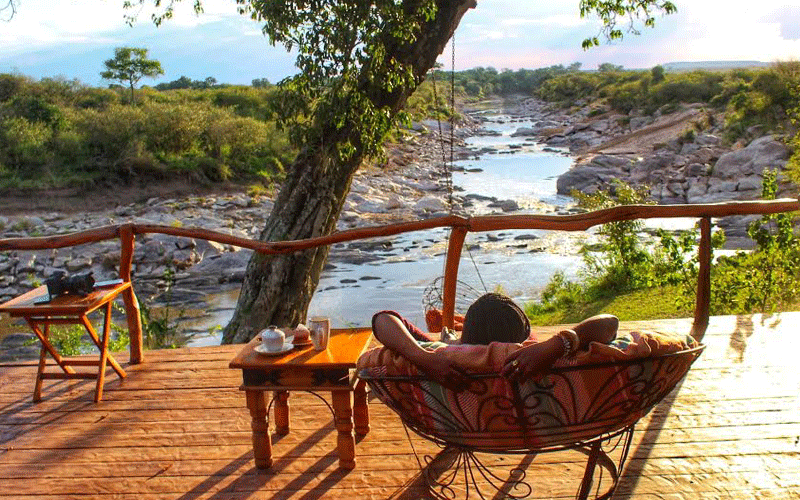The great migration flop

When I got another chance to head over to Masai Mara Game Reserve, all I hoped to see was the epic crossing of the wildebeest from the plains of the Serengeti in Tanzania to the reserve.
It was the only exciting thing attracting visitors to the Mara, which also happens to be the peak tourism season for Kenya.
This buzz, coupled with pressure from social media, which was awash with photos of travellers having a great time during crossings compelled me not to miss out on the wildebeest migration.
Covid-19 restrictions had locked out international tourists forcing most of the camps to device ways to attract local guests by lowering facility costs, well up to 50 per cent, thus the upsurge of local visitors.
For instance, Rekero Asilia camp, where I stayed was charging $200 (Sh21,780) per night per person if you flew in.
Guests that went by road were charged $150 dollars (Sh16,335) per person per night.
Fredrick Riongo, the manager of the camp said they have witnessed the largest number of local tourists this season, aided by travel restrictions earlier imposed on international travels that closed borders to help contain the spread of Covid-19.
“Most of the camps are full at 80 per cent, thanks to Kenyans for coming out in droves,” he said.
The most exciting thing about this particular camp is that one gets to watch the wildebeests crossing right in front of their eyes on Talek River, one of the five tributaries of Mara River.
The river is just 150m from the camp’s dining area and its nine classic rooms have private verandas, which also, can act as chill spots for guests as they view the wildlife.

Part of my preparation ahead of the game trip was to learn alittle bit about the migratory routes of the wildebeests and the best times to watch the animals thundering across the rivers in search of water and greener pastures.
I learnt that the great migration from Serengeti occurs from July to September.
These are the best times to track and see the annual wildebeest migration in Masai Mara.
It was August, and I figured I had plenty of time to enjoy the spectacular largest single movement of wild animals in the world.
So, you can imagine my dissappointment when, while waiting at the camp, we were informed that the animals had changed their route and may not be passing at the point during our two night stay at the camp.
Though the camp boasts of having a private view of this spectacular sight, I learnt from this trip to always have an open mind when heading to the Mara.
The migration is a natural phenomenon and just like a bet, chances are you might see or not see the crossing.
The exact timing of the wildebeest migration is completely dependent upon rainfall patterns, making it difficult to predict with any certainty.
I learnt that a particularly heavy or light rainfall might completely alter the movement of the massive herd, thus making planning your safari an occasionally complicated affair.
So it pays to spend as much time as possible in the reserve so that you can adjust to the sometimes mercurial movements of the animals.
Alternative plan
But we did not have to go back home. We made peace with the fact that we were not going to watch the migration and decided to focus on other activities the expansive game reserve had to offer.
Yes, the river crossings are exciting, but they’re only a small part of this epic journey.
Activities, such as game drives, cultural visits, chasing the sunset and sunrise while enjoying the quiet of the wild, nature walks, hot air balloon rides still give you a great safari experience.
Unlike my previous stay at the camp, a lot of things owing to the Covid-19 pandemic had changed, in terms of safety measures adapted to contain the virus.
There used to be nightly briefs where guests would gather round a bonfire and share their highlights of the day, but this time round everyone was on their own.
We were also served on our own tables as opposed to to sitting together like one big family.
Either way, I still enjoyed my stay at the place as the service still had the same level of excellence.
We woke up early in the morning for a game drive and the Mara sunrise never disappoints.
Game drives are always full of new facts to learn, particularly if you have a knowledgeable guide like ours, Francis Sukuli.
We found Ole Polos, one of the resident lions, shy under a croton bush. Francis told me that the Topi Pride had spread out, some crossing over to Serengeti.
We saw a hyena and a committee of vultures fighting for a carcass that had been left behind by other carnivores.
Francis taught us the difference between the vultures, for instance, the big wrinkly head vulture, whose beaks are adapted for cutting into fresh carcasses while the rupelle vulture’s beak is well adapted to pierce a carcass from the rear end (anus), eyes and intestines as their beaks are not cut out for piercing through the skin.
At the moment, activities are still going on at the park albeit with fewer tourists as the wildebeests move back to Serengeti.







